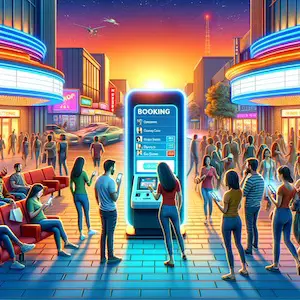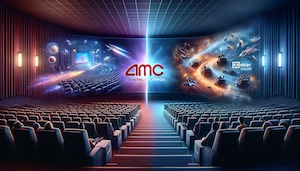The size of a cinema screen is not just a matter of architectural design; it’s a pivotal element that defines the viewing experience, bridging the gap between mere watching and complete immersion. From the cozy corners of local theaters to the grandeur of IMAX experiences, the dimensions of cinema screens play a critical role in bringing stories to life, captivating audiences, and transporting them to realms beyond imagination.
This article delves into the various factors that influence cinema screen sizes, including traditional screens, the marvel of IMAX, and the nostalgic charm of drive-in theaters. Alongside, we’ll explore the impact of screen size on picture quality and resolution, and how these elements coalesce to craft unforgettable cinematic moments. Whether you’re a film aficionado or simply curious about what goes into creating your movie-going experiences, join us in unraveling the secrets behind the screens.

Table of Contents
Average Cinema Screen Size
The size of cinema screens can vary widely, depending on the type of theater, the geographical location, and the viewing formats offered (such as IMAX or traditional). However, there is a general range that most cinema screens fall into, which can be considered the “average” size. This average helps set expectations for both cinema-goers and those involved in cinema design and film production.
For traditional cinemas, which include multiplexes and single-screen theaters showing mainstream movies, the average screen size typically ranges from 45 to 65 feet in width. This size range is considered optimal for providing an immersive viewing experience without necessitating an excessively large venue or cutting-edge projection technology that might be required for larger screens.
IMAX theaters, known for their larger-than-life screen sizes, dramatically exceed these dimensions, with screens often starting at 72 feet in width and reaching up to or exceeding 100 feet. However, these are special cases and represent the higher end of screen sizes available to movie-goers.
Drive-in theaters, which have seen a resurgence in popularity, offer a different range of screen sizes. Due to the need to accommodate viewers in vehicles, drive-in screens can vary greatly but typically range from 50 to 100 feet wide, aiming to ensure visibility for every attendee.
Considering the diversity of cinema formats—from small, independent theaters to massive IMAX venues—the average cinema screen size across all types hovers around 50 to 70 feet in width. This average takes into account the vast majority of theaters that cater to a traditional cinematic experience while acknowledging the existence of larger formats that push the boundaries of screen size.
In conclusion, while the “average” cinema screen size offers a baseline understanding, the true measure of a screen’s impact lies in its ability to convey stories in a manner that captivates and immerses the audience, regardless of its dimensions.
Traditional Screens
When we talk about traditional cinema screens, we’re diving into the core of the cinematic experience as it’s been known for decades. These screens, typically found in multiplexes and single-screen theaters, range in width from about 45 to 65 feet. This size bracket isn’t arbitrary; it’s carefully chosen to balance the need for a large, engaging viewing surface with the practical limitations of space and the technological capabilities of standard digital projection systems.
Traditional cinema screens have a charm and a purpose that go beyond mere dimensions. They are designed to deliver a viewing experience that is both immersive and comfortable, regardless of where you’re seated in the auditorium. The aim is to fill your field of view without overwhelming your senses, allowing you to absorb and enjoy the narrative unfolding before you without needing to physically move your head to follow the action.
The aspect ratio for these screens, which is the ratio of the screen width to its height, usually aligns with the most common formats used in film production, such as 1.85:1 or 2.39:1. This compatibility ensures that movies are shown as the filmmakers intended, without the need for cropping or letterboxing, which can detract from the visual experience.
Moreover, traditional screens strike a careful balance between size and resolution. As screen size increases, so does the need for higher resolution to maintain crisp, clear images. Most modern theaters equipped with traditional screens utilize digital projection technology capable of delivering high-definition images that can meet this requirement, ensuring that even the smallest details are visible, from the texture of a character’s clothing to the subtle expressions on their faces, enhancing the storytelling impact.
In addition to technical considerations, the size of traditional cinema screens is also influenced by the architectural design and seating arrangement of the theater. The goal is to ensure that all members of the audience, whether they are in the front row or at the back of the auditorium, have a clear and unobstructed view of the screen. This inclusivity is key to the communal experience of cinema, allowing everyone to share in the emotions, laughter, and tears that great films evoke.
In summary, traditional cinema screens serve as the heart of the movie-going experience, offering a perfect blend of size and technology to bring stories to life. While they may not boast the sheer scale of IMAX or other large-format screens, their dimensions are thoughtfully calibrated to maximize viewer engagement, making them a beloved standard in the film industry.
IMAX Screens
IMAX screens represent the pinnacle of cinematic immersion, designed to take the movie-going experience to unprecedented levels. Standing for Image Maximum, IMAX is more than just a larger screen; it’s a comprehensive system that includes advanced projection technology and a specific theater design to create an environment where films are not just watched but lived.
The size of IMAX screens is truly awe-inspiring, with standard IMAX screens measuring at least 72 feet wide. However, this is just the beginning. Many IMAX theaters boast screens that stretch even wider, with some reaching over 100 feet in width and 80 feet in height. These gigantic screens envelop the viewer, filling their entire field of vision and creating a sense of being part of the film rather than merely observing it. This scale, combined with the steep stadium seating often found in IMAX theaters, ensures that every seat is the best seat in the house, providing an unparalleled viewing experience.
IMAX’s immersive effect is further enhanced by its unique aspect ratio. Unlike traditional cinema screens, which adhere to standard film aspect ratios like 1.85:1 or 2.39:1, IMAX screens are closer to a square, often utilizing a 1.43:1 ratio. This format allows more of the film to fill the viewer’s field of view, especially in vertical dimensions, making for a more captivating and enveloping experience.
But IMAX is not just about size; it’s also about clarity and detail. IMAX screens require films to be shot or specially formatted with high-resolution cameras, significantly higher than standard digital projections. This commitment to high resolution ensures that, despite their vast size, IMAX screens retain crystal-clear image quality, with vibrant colors and sharp details that can reveal textures and subtleties lost on smaller screens.
The IMAX experience is also defined by its sound system, which is as advanced as its visual technology. Custom-designed to match the theater’s acoustics, the IMAX sound system delivers clear, precise, and immersive audio that complements the visual spectacle. The result is a sensory experience that can make audiences feel the roar of a spaceship launch or the whisper of a breeze with equal intensity.
In addition to their role in screening blockbuster films, IMAX screens are also pivotal in educational and documentary contexts, where the detail and scale they offer can bring natural wonders and scientific explorations to life in a way that no other medium can match.
In summary, IMAX screens are more than just a larger format; they are a complete cinematic experience designed to immerse and engage the viewer in the narrative. Through their impressive size, unique aspect ratio, high-resolution imagery, and unparalleled sound, IMAX theaters transform movie-going from a passive activity into an active, immersive journey that stays with the audience long after the credits roll.
Factors Influencing Screen Size
The size of a cinema screen is not determined by chance. Instead, it’s the result of careful consideration of various factors that influence how a movie is presented and experienced. These factors ensure that the screen size is optimized for the best possible viewing experience, taking into account the specific needs of the film being shown, the architecture of the theater, and the comfort of the audience. Here are the key factors influencing cinema screen size:
Theater Size and Capacity
One of the primary considerations in determining screen size is the physical size of the theater and its seating capacity. Larger theaters, designed to accommodate hundreds of viewers, naturally require larger screens. The goal is to ensure that everyone in the audience, regardless of their seating position, can have an unobstructed view of the screen without compromising image quality or the viewing experience. Conversely, smaller theaters with fewer seats might opt for moderately sized screens that match the scale of the space, ensuring that the screen fills the audience’s field of view appropriately without overwhelming the room.
Aspect Ratio
The aspect ratio of a film, which is the ratio of its width to its height, plays a crucial role in determining screen size. Most films are produced in standard aspect ratios such as 1.85:1 (widescreen) or 2.39:1 (CinemaScope). The screen size and shape need to accommodate these formats without the need for significant alteration or compromise in how the film is displayed. For instance, a film shot in CinemaScope might require a wider screen to present its visuals as intended by the filmmakers, without letterboxing or cropping the image.
Viewing Distance
Optimal viewing distance is another critical factor. The size of the screen should allow viewers sitting at both the front and the back of the theater to enjoy the film without discomfort. Those in the front should not have to move their heads to take in the entire scene, while those at the back should still be able to discern fine details in the image. This consideration is vital for maintaining immersion and ensuring that all audience members have a satisfying cinematic experience.
Technological Considerations
The capabilities of projection and sound technology also influence screen size decisions. Larger screens require projectors that can produce bright, high-resolution images across the entire surface without loss of quality. Advances in digital projection technology have made it possible to illuminate larger screens effectively, but the choice of screen size still needs to align with the technological capabilities of the projection system to ensure that the image quality is not compromised.
Audience Preferences
Finally, audience preferences and expectations can influence screen size. In an era where home entertainment systems are increasingly sophisticated, cinemas must offer a viewing experience that is distinctly superior. This has led to a trend towards larger screens, which provide an immersive experience that cannot be replicated in a home setting. Cinemas may adjust their screen sizes based on feedback from their audiences or trends in the industry, aiming to provide the most engaging and satisfying experience possible.
In conclusion, the size of cinema screens is the result of a delicate balance between various factors, including the physical dimensions of the theater, the aspect ratio of the films shown, optimal viewing distances, technological capabilities, and audience expectations. These considerations ensure that whether you’re watching a blockbuster in an IMAX theater or an indie film in a small local cinema, the screen size is designed to offer the best possible viewing experience.
Picture Quality and Resolution
In the realm of cinema, the marriage of picture quality and resolution with screen size is crucial for crafting an unforgettable viewing experience. As screens have grown larger to meet the demand for more immersive experiences, the importance of maintaining and enhancing picture quality and resolution has never been more paramount. This relationship between screen size and image fidelity is a delicate balance, where advancements in technology play a vital role in pushing the boundaries of what is visually possible in theaters.
The Importance of Resolution
Resolution refers to the number of pixels used to display an image. Higher resolutions mean more pixels, which translates to finer details, sharper images, and a more lifelike representation on screen. In the context of large cinema screens, high resolution is essential to ensure that the image remains clear and detailed, even when projected over vast areas. As screen sizes increase, the pixel density must also increase to avoid pixelation, where the individual pixels become visible, or the image appears blurred.
This is where advancements in digital projection technology come into play. Modern digital projectors are capable of displaying images in 4K resolution or higher, providing four times the detail of standard 1080p HD. This leap in resolution is critical for large screens, ensuring that the picture remains crisp and detailed, no matter the size of the screen or the distance of the viewer.
Enhancing Picture Quality
Beyond resolution, picture quality encompasses color accuracy, contrast ratios, and brightness levels — all of which contribute to the overall visual experience. High-quality projection systems are designed to deliver wide color gamuts, ensuring that colors are vibrant, accurate, and true to the director’s vision. Contrast ratio, the difference between the darkest and brightest parts of the image, is equally important. A higher contrast ratio allows for deeper blacks and more brilliant whites, adding depth and dimension to the image.
Brightness is another critical factor, especially in large-screen formats where light has to cover more surface area. Adequate brightness ensures that the image is easily visible and engaging, even in scenes with subtle lighting. Modern projection systems have made significant strides in this area, providing the luminosity required to make images pop on large screens.
The Role of Filmmaking Techniques
Filmmakers and cinematographers also play a crucial role in optimizing picture quality and resolution for large screens. By employing high-resolution cameras and sophisticated filming techniques, filmmakers can capture extraordinary detail and dynamic range, ensuring that their creations look stunning on any screen size. Post-production processes, including color grading and visual effects, are tailored to enhance picture quality further, ensuring that every frame can stand up to the scrutiny of a large-format presentation.
Future Trends
As cinema technology continues to evolve, so too will the standards for picture quality and resolution. Emerging technologies like 8K resolution and beyond promise to deliver even more detailed and lifelike images, pushing the boundaries of what audiences can expect from their cinema experience. Similarly, advancements in laser projection and HDR (High Dynamic Range) are set to redefine the standards for brightness, color, and contrast, ensuring that the future of cinema is not only larger than life but also clearer, sharper, and more vibrant than ever before.
In conclusion, the interplay between picture quality, resolution, and screen size is foundational to the cinematic experience. As audiences continue to seek out more immersive and visually stunning presentations, the cinema industry’s commitment to advancing technology in these areas ensures that each trip to the theater remains a magical and visually breathtaking journey.
FAQs
What is the average size of a traditional cinema screen?
Traditional cinema screens typically range from 45 to 65 feet in width. The size can vary based on the theater’s capacity and design, with larger theaters tending to have bigger screens.
How does IMAX screen size compare to traditional cinema screens?
IMAX screens are significantly larger, with standard sizes starting at 72 feet wide. Some IMAX screens can even exceed 100 feet in width, offering a much more immersive viewing experience compared to traditional screens.
Can the aspect ratio of a movie affect the viewing experience on different screen sizes?
Yes, the aspect ratio of a movie can significantly impact the viewing experience. Movies shot in wider aspect ratios may require wider screens to be displayed without cropping or letterboxing, affecting how much of the image is visible and how immersive the experience is for the audience.
See Related Posts

Average Cinema Screen Size

Movie Theater Popcorn at Home

Movie Theaters on Cruise Ships

Recliner Seat Movie Theater

Do you have to book Cinema Tickets in advance?

AMC Digital vs. Dolby

Best Seats in Theater for Movie

Biggest IMAX Screens in NYC

Nutritional Value of Movie Theatre Popcorn

